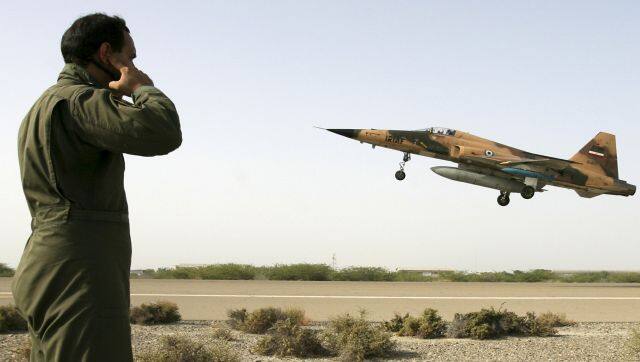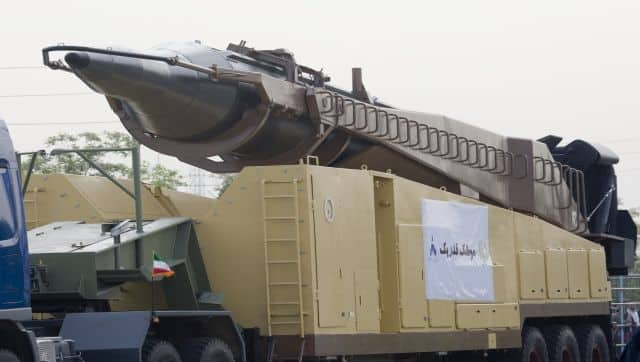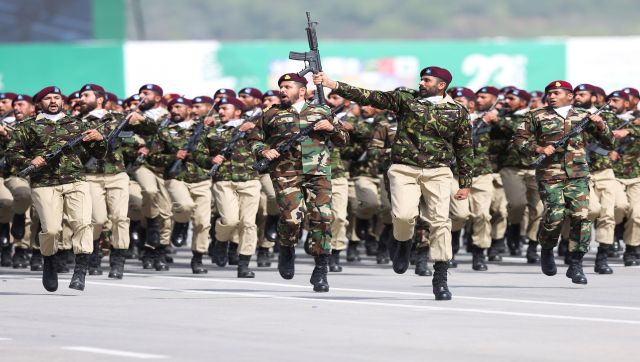It’s a game of tit-for-tat. Less than 48 hours after Iran launched an attack on Pakistani territory, Islamabad has carried out retaliatory strikes against militant targets on Iranian soil. Pakistan’s ministry of foreign affairs in a statement on Thursday (18 January) said that it had undertook a series of highly coordinated and specifically targeted precision military strikes and killed a number of terrorists during the intelligence-based operation codenamed ‘
Marg Bar Sarmachar ’. It added that its actions were only aimed at the “terrorists” known as sarmachars. And just as Iran had said following the strikes that it respected Pakistan’s sovereignty, so did Islamabad. “Pakistan fully respects the sovereignty and territorial integrity of the Islamic Republic of Iran,” the foreign ministry said, “The sole objective of today’s act was in pursuit of Pakistan’s own security and national interest which is paramount and cannot be compromised.” Iran’s media has reported loud explosions from Siestan-o-Balochistan province, adding that three women and four children have been killed. This retaliation from Pakistan once again raises fears of a bigger conflict looming, with some even expressing concern of an all-out war between the two nations. As worries escalate, here’s a comparison between the military firepower of Iran and Pakistan, and whether it would be enough to act as a deterrent to a full-scale military conflict. [caption id=“attachment_13628042” align=“alignnone” width=“640”] A man looks at a television screen after the Pakistani foreign ministry said the country conducted strikes inside Iran targeting separatist militants, two days after Tehran said it attacked Israel-linked militant bases inside Pakistani territory, in Karachi, Pakistan. Reuters[/caption] Persian might against Pakistan power Iran and Pakistan are two very influential nations in the West Asia region. Iran, with its rich history and status as a Shia-majority nation, stands as a powerhouse, while Pakistan, a Sunni-majority country in South Asia, has been a key player in the regional security dynamics. As per the recent Global Firepower rankings, which lists the
most powerful militaries in the world, Pakistan is ninth with a score of 0.1711 whereas Iran has been placed on the 14th spot (0.2269) out of 145 countries. According to Global Firepower, while Iran has a defence budget of $9.95 billion whereas Pakistan has allocated a budget of $6.34 billion. When it comes to manpower, Pakistan comes out on top, having 6.54 lakh active personnel in their armed forces, while Iran has 6.1 lakh personnel. However, Iran’s military establishment, especially the Islamic Revolutionary Guards Corps (IRGC), does not depend merely on the state budget for its funding, according to the Washington-based Foundation for Defense of Democracies (FDD). “The military establishment controls (one-fifth) of the market value of companies listed on the Tehran Stock Exchange and owns thousands of other companies, all of which generate revenue for the armed forces,” the FDD reported. “Additionally, the IRGC controls a significant portion of Iran’s underground economy.” Land power: Iran vs Pakistan To explain their military strengths, we now break down each of their military branches, starting with their land assets. Pakistan boasts of a stronger arsenal — it has 3,742 tanks, also known as ‘war elephants’ as compared to Iran’s 1,996. Also, when it comes to self-propelled and towed artillery, Pakistan has the higher numbers. [caption id=“attachment_13628212” align=“alignnone” width=“640”]
A Pakistan army tank takes part in a rehearsal in Lahore. When it comes to tanks, Islamabad trumps Tehran. File image/Reuters[/caption] Iran, however, has more armoured vehicles (65,765) than Pakistan (50,523) and also more mobile rocket projectors — 775 in comparison to 602 respectively. For the unaware, armoured vehicles are crucial in deploying infantry to the battlefield quickly. They not only add firepower but also speed in an operation to ensure better manoeuvering during battle. Naval might The Iranian Navy is, comparatively, a modest force that has neither an aircraft carrier nor a destroyer. As per Global Firepower, Pakistan has a fleet strength of 114 vessels whereas Iran has 101. Notably, neither countries have aircraft carriers. Pakistan does trump Iran when it comes to destroyers — two vs zero, as well as frigates (9-7), and corvettes (7-3). [caption id=“attachment_13628232” align=“alignnone” width=“640”]
 An Iranian Air Force F-5E fighter plane takes off during manoeuvres in southern Iran. Tehran boasts of a relatively modest air force. File image/Reuters[/caption] Flying high In the ever-evolving realm of military prowess, the air forces of nations play a pivotal role in shaping strategic capabilities. Iran’s air force comprises a total of 551 aircraft, with 186 fighter jets, 23 dedicated attack aircraft, 129 helicopters and 10 special mission aircraft. This diverse fleet highlights Iran’s commitment to maintaining a versatile and technologically advanced air force. On the other hand, Pakistan has 1434 aircraft, of which 387 are fighter jets, 90 are dedicated aircraft, 352 helicopters and 25 special mission aircraft. It’s important to note here that Iran also has a full arsenal of drones. In fact, the IRGC has a cyberattack unit that is known to have been responsible for several attacks abroad. Missiles and nuclear strength If reports are to be believed Iran has no nuclear weapons. As The Atlantic notes, “They have a ballistic-missile program but no long-range missiles that can reach the United States.” On the other hand, Pakistan, as per a report published by Stockholm International Peace Research Institute, has 170 nuclear weapons in its stockpile. This makes it the world’s sixth largest nuclear arsenal. Iran has approximately 1,000 strategic missiles, believed capable of striking throughout the Gulf and beyond. Tehran has also domestically produced Shahab-3 strategic intermediate-range ballistic missiles (IRBM), with a reported range of up to 1,000 km, the Ghadr-1 with an estimated 1,600 km range and a Shahab-3 variant known as Sajjil-2 with a reported range of up to 2,400 km, according to Reuters reports. If true, Israel and much of eastern Europe would be within range. [caption id=“attachment_13628242” align=“alignnone” width=“640”]
An Iranian Air Force F-5E fighter plane takes off during manoeuvres in southern Iran. Tehran boasts of a relatively modest air force. File image/Reuters[/caption] Flying high In the ever-evolving realm of military prowess, the air forces of nations play a pivotal role in shaping strategic capabilities. Iran’s air force comprises a total of 551 aircraft, with 186 fighter jets, 23 dedicated attack aircraft, 129 helicopters and 10 special mission aircraft. This diverse fleet highlights Iran’s commitment to maintaining a versatile and technologically advanced air force. On the other hand, Pakistan has 1434 aircraft, of which 387 are fighter jets, 90 are dedicated aircraft, 352 helicopters and 25 special mission aircraft. It’s important to note here that Iran also has a full arsenal of drones. In fact, the IRGC has a cyberattack unit that is known to have been responsible for several attacks abroad. Missiles and nuclear strength If reports are to be believed Iran has no nuclear weapons. As The Atlantic notes, “They have a ballistic-missile program but no long-range missiles that can reach the United States.” On the other hand, Pakistan, as per a report published by Stockholm International Peace Research Institute, has 170 nuclear weapons in its stockpile. This makes it the world’s sixth largest nuclear arsenal. Iran has approximately 1,000 strategic missiles, believed capable of striking throughout the Gulf and beyond. Tehran has also domestically produced Shahab-3 strategic intermediate-range ballistic missiles (IRBM), with a reported range of up to 1,000 km, the Ghadr-1 with an estimated 1,600 km range and a Shahab-3 variant known as Sajjil-2 with a reported range of up to 2,400 km, according to Reuters reports. If true, Israel and much of eastern Europe would be within range. [caption id=“attachment_13628242” align=“alignnone” width=“640”] A military truck carrying a Ghadr-1 missile drives by during a military parade to commemorate Army Day in Tehran. File image/Reuters[/caption] But as Kamran Bokhari, vice-president of Middle Eastern and South Asian Affairs with Stratfor, told Al Jazeera, “All of this is shrouded in mystery and not really transparent. We don’t have a very good understanding of what Iran can actually do.” On the other hand, Pakistan has a missile programme boasting of mobile short- and medium-range weapons. Shaheen 2 has the longest range of up to 2,000 km. Iran’s sphere of influence If it comes to a full-blown conflict between the two countries, Iran, however, may have the edge as it has over decades shaped an “axis of resistance”, a web of proxy forces, patronage and influence networks across the region, from Syria to Afghanistan. One of Iran’s main and biggest proxy is the
Hezbollah . Emerging as a fighting force in the early 1980s, it has become one of the most effective fighting groups and has waded into the ongoing Israel-Hamas war. The US government has said that it believes that Iran provides the group with an estimated $700 million in support annually. [caption id=“attachment_13628252” align=“alignnone” width=“640”]
A military truck carrying a Ghadr-1 missile drives by during a military parade to commemorate Army Day in Tehran. File image/Reuters[/caption] But as Kamran Bokhari, vice-president of Middle Eastern and South Asian Affairs with Stratfor, told Al Jazeera, “All of this is shrouded in mystery and not really transparent. We don’t have a very good understanding of what Iran can actually do.” On the other hand, Pakistan has a missile programme boasting of mobile short- and medium-range weapons. Shaheen 2 has the longest range of up to 2,000 km. Iran’s sphere of influence If it comes to a full-blown conflict between the two countries, Iran, however, may have the edge as it has over decades shaped an “axis of resistance”, a web of proxy forces, patronage and influence networks across the region, from Syria to Afghanistan. One of Iran’s main and biggest proxy is the
Hezbollah . Emerging as a fighting force in the early 1980s, it has become one of the most effective fighting groups and has waded into the ongoing Israel-Hamas war. The US government has said that it believes that Iran provides the group with an estimated $700 million in support annually. [caption id=“attachment_13628252” align=“alignnone” width=“640”] An Iranian waves the Iranian flag and Lebanon’s Hezbollah flag in front of a picture of the Al-Aqsa mosque in Tehran. File image/Reuters[/caption] Tehran also backs the
Houthi rebels in Yemen, providing them with cash and hi-tech weaponry, including drones that can operate in the air and water. Presently, the Houthis have wreaked terror in the Red Sea, attacking merchant vessels, prompting a strong response from the United States as well as the United Kingdom. However, it’s important to note that the numbers don’t portray the true picture, as is reflected by the Russia-Ukraine war. On paper, Moscow has the bigger and stronger military, but Kyiv has been able to fend off Vladimir Putin’s men and protect their land. With inputs from agencies
A day after Iran launched an attack against Pakistan, Islamabad retaliated with its own operation. The actions have fuelled fears of a full-blown conflict between the two nations. Here’s a comparison of their militaries — from land assets to missile capabilities
Advertisement
End of Article


)

)
)
)
)
)
)
)
)



